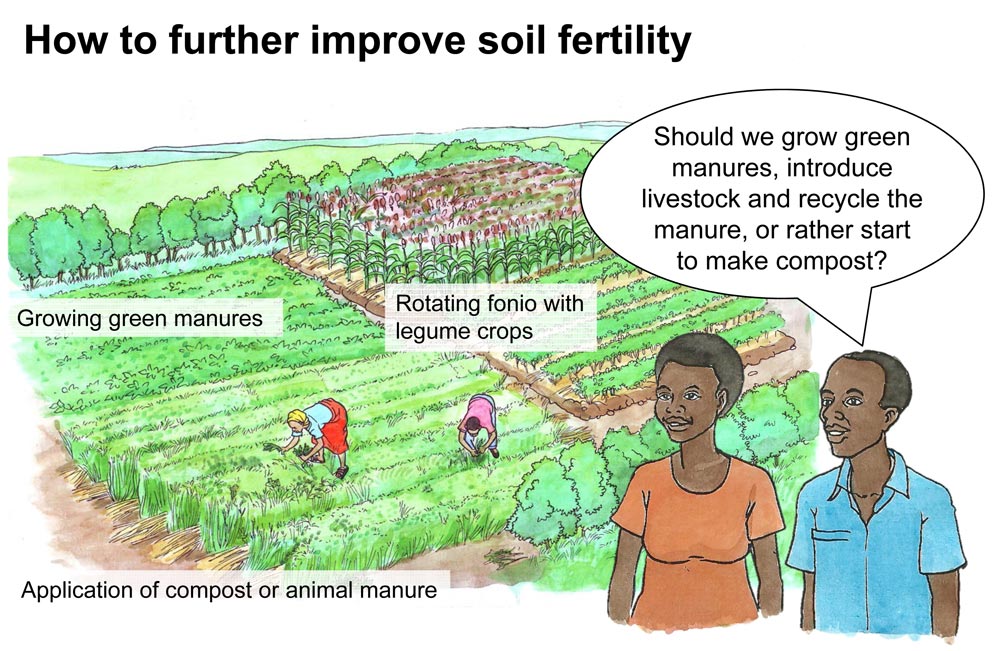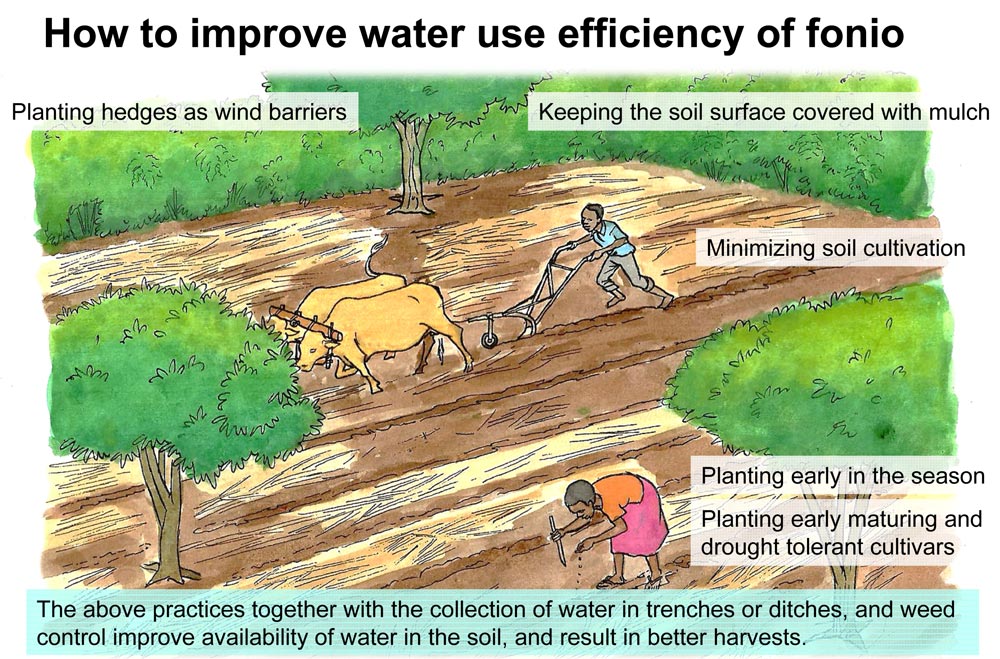Improving soil fertility

Fonio is seen as a very hardy crop that grows well on poor soils. Due to this claim farmers usually plant fonio on very poor soils without considering any efforts to improve soil fertility or fertilise the crop. Although little is known about the nutrient requirements of fonio, the crop will most probably give better yields in a fertile soil.
Soil fertility management fi rst serves an entire production system or an entire crop rotation, and only in second priority an individual crop. So, even if fonio does not require high soil fertility, improvement in soil fertility will improve growth of all crops.
Soil fertility management should start from preserving the soil from erosion and degradation, and include practices that feed the soil with organic matter.
Practices that can contribute to soil fertility improvement in fonio production: a) Soil conservation. When the soil is left bare, it is exposed to wind and water erosion, and to high sun intensities. Therefore, where wind is frequent, windbreaking hedges around the fields are necessary to prevent wind erosion and reduce the otherwise high evaporation and evapotranspiration of water from crops and soil. They also help prevent strong winds carrying away the small seeds after sowing.
Unlike ploughing, where the entire soil surface is returned and exposed to sun and wind, soil disturbance is minimized in reduced soil cultivation, which essentially contributes to conservation of soil water. Especially in case of ploughing, sowing should be done immediately after soil preparation. On sloping land, land preparation must be done across the slope to minimise run-off water with supporting suitable structures which stabilise and hold the soil, and trap erosion. B) Crop rotation and intercropping. Fonio is often grown in rotation with other cereals like sorghum and millet. In some areas it is grown after rain-fed rice as a short-cycle crop before another (cereal) crop is sown in the same season. Continuous cultivation of cereals, particularly with poor soil fertility management practices, decreases soil fertility and encourages build-up of soil-borne diseases, pests and weeds. To improve soil fertility fonio should be grown in a planned rotation with nitrogen-fi xing leguminous crops like beans, cowpeas, groundnuts or leguminous green manure crops and other appropriate crops. Besides fi xing nitrogen in the soil for subsequent crops, legumes interrupt the lifecycles of soil-borne pests and diseases, which are hosted by grass crops. Conversely, growing fonio before peanuts, cowpeas or sesame can reduce development of Macrophomina phaseolina, a fungus that causes charcoal rot on these and many other plant species. C) Addition of organic materials. Application of compost, animal manure or biomass from green manure crops to the soil provides essential organic material for maintanence of soil fertility. While green plant materials and animal manures provide food for soil organisms and nutrients to plants, compost mainly improves soil properties like soil structure and soil water holding capacity.
Planned cultivation of leguminous green manures like mucuna during the off-season, if suffi cient water is available, protects the soil from erosion, fi xes nitrogen from the air, and supplies great amounts of biomass for soil organic matter management. D) Recycling crop residues on the field. In order to minimise loss of nutrients from the field, crop residues should be returned to the piece of land where they were harvested. If the residues are fed to livestock, the dung of the animals should be returned to the fields and mixed into the soil, or composted together with plant materials to improve the quality before application.
Note: For organic farming, burning of the crop residues is not recommended, as this results in loss of valuable organic matter. E) Use of mineral fertilizers. In principle application of selected mineral P and K fertilizers is allowed in organic farming, whereas the use of mineral N fertilizers is not allowed. Use of such fertilizers should only be the last option in soil fertility management and is only recommended in case of heavy defi -ciency. Use of commercial fertilizers may hardly be economic in fonio production. Nevertheless, before using mineral fertilizers certified organic farmers should check prevailing regulations.
Proper water management

Fonio is well adapted to annual rainfall of 700 to 1000 mm. However, towards the Sahelian zone annual rainfall drops lower. Effective management of water is therefore essential in traditional rain-fed fonio production and is now becoming even more important due to the increasing occurrence and severity of droughts.
Recommended practices to improve water use efficiency in fonio production include:
- Early planting in the season. Early sowing can be advisable in order to optimise the use of rainwater, particullarly if weather forecasts depict a short rainfall periods.
- Early maturing cultivars. In areas with limited rainfall amounts, or when planting is done close to the end of the rainy season, early maturing cultivars are preferable.
- Mulching. Using the previously harvested crop residue to mulch the field can reduce the rate of evaporation of water from the soil.
- Reduced tillage. Reduced or no tillage strongly reduces loss of soil water through evaporation compared to ploughing of an entire field.
- Proper weed control. Removal of weeds reduces the rate at which they compete with fonio for water, leaving more moisture to the crop.
- Reducing plant population. This is an important consideration in arid regions where rains are brief and unreliable, and where there is no irrigation.

Comments
Post a Comment